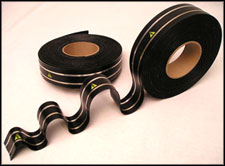Throughout the course of a year WCS fields many questions regarding the products, the need and the method (s) used for protecting traps from harmful rust. Rather than trying to be all things to all people, if you know what I mean, I'm going to limit this post to the use of the
protective dip product which is mixed with gasoline, sometimes commonly referred to as
Speed Dip. While there are a number of trap dips on the market that utilize gasoline for dilution,
Speed Dip is the trade name developed by Andy Stoe of Penn Yan, NY. and has been in widespread use by trappers for 25+/- years.
Speed Dip is a petroleum-based product and is available in black, brown, or white colors. It is packaged in paint can containers and is marketed in quart and gallon sizes. Speed Dip should be diluted 3 to 1, meaning for every unit of
Speed Dip you would ADD 3 units of white gasoline. For example for every quart of Speed Dip product, you would ADD 3 quarts of white gasoline, making a total of 4 quarts of mixture.
PLEASE NOTE: There are two important points to remember when working with any gasoline products...this should be used out of doors, in the open air, NOT IN THE GARAGE. Also, SPEED DIP is highly flammable once mixed and needs to be mixed and stored in a proper container.
I like to store the Speed Dip mixture in a 5 gallon bucket, new buckets and lids can be purchased at you favorite big box home improvement store. Once mixed, according to the ratio mentioned above, you can dip your traps as needed and seal the bucket with a tight fitting lid to avoid evaporation. Over time, if the mixture becomes weak, or is not coating your traps as well as you'd like, simply add alittle Speed Dip concentrate to your already prepared mixture.
Let me stop right here and point out a problem area we've seen trappers or wildlife operators get themselves in to ! We
ALWAYS,
ALWAYS recommend using the highly refined white gas (otherwise known as Coleman fuel) to mix with the SPEED DIP concentrate as it results in a nice dry, shiny, non-stick protective coating on your traps. Some folks decide to go down their own path and take the "cheap" route and buy the least expensive unleaded fuel they can find. Then they wonder WHY their traps remain sticky & gummy, making their hands black every time they touch them. Heed my warning....'nough said !!
Now, working out of doors, you've mixed up your speed dip 3 to 1 as we recommend into a 5 gallon container or the like and you're ready to dip your traps. STOP...before you get started their are a few things you should consider. Clothing for one, the speed dip will coat your clothing just as well as your traps, and I don't care how careful you think you're going to be, wear clothing & shoes that you want mind becoming stained. Gloves, not the thin latex gloves, some thicker rubber gloves to protect your hands. Eye protection, you don't want to splash any mix and get some in your eyes. Now you're ready...........
For foothold and bodygrip traps you simply immerse them into your bucket and if there are spots that don't quite fit into the solution use a disposable paint brush to cover the exposed area. For cage traps, you can use a shallow pan, something like an oversized cookie sheet, it only needs to be approx. 1" deep. Pour your solution into the pan, then place a cage in the shallow pan and roll it so all four sides are coated, including the back and the front door. The paint brush really comes in handy for cages. Hang your dipped traps outside on a rack or in a bush or tree for 1 - 3 days, depending on temperature and air circulation your traps will be dry and ready to go.
It is important to note that traps can be dipped right out of the box, there is no need to rust or even degrease them prior to dipping.
Dip solution can be stored for an indefinite period in a proper container. When traps become rusty or the protective coating is worn off from use, simply re-dip.





